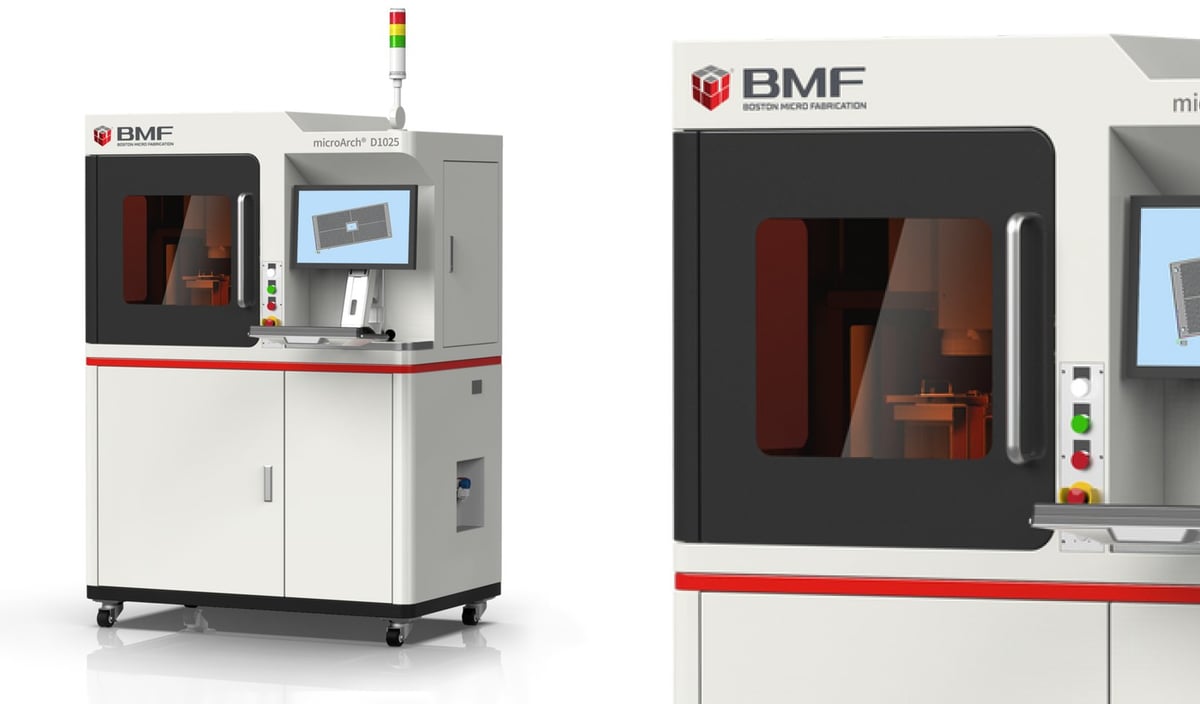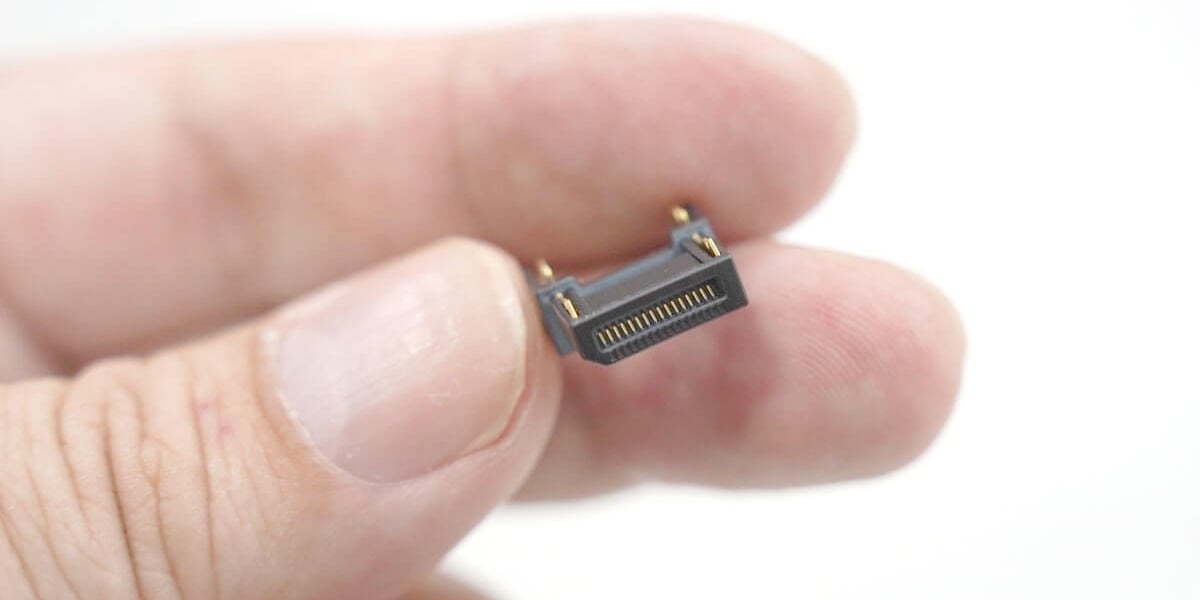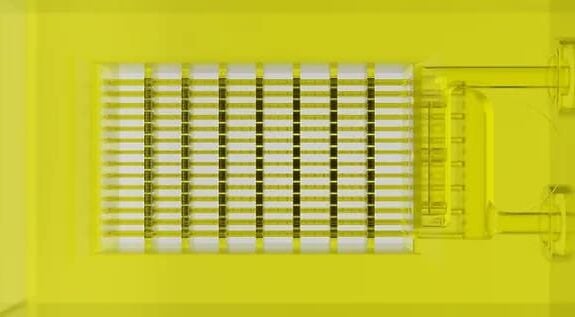“It’s our goal that the performance of machines is not user dependent,” says John Kawola, CEO of projection micro-stereolithography (PµSL) 3D printer manufacturer Boston Micro Fabrication (BMF). “If your machine is user-dependent, that’s not great. You’d want a machine where you could say, ‘Even I can do it!’ And companies want that, too. So it’s our goal to take away as much of the user skill and judgment in terms of setting up builds and hitting performance targets.”
Kawola sat down with All3DP at the company’s Rapid + TCT booth that showcased its latest high-precision 3D printer to talk about the new system, machine automation, micro 3D printing applications, and big things to come for the additive industry’s smallest side.

This past May, BMF launched the MicroArch D1025 – a PµSL 3D printer able to print at a resolution of 10 microns or 25 microns, or in hybrid mode with both resolutions in the same print layer or in different layers. It’s “the industry’s first line of hybrid printing solutions for micro-scale and ultra high-resolution applications,” the company says, with automation features that make the precision-manufacturing machine easier to use with about two or three days of operator training.
BMF has been an energetic player in future markets for micro 3D printing, and has conducted its own research in emerging applications like organ-on-a-chip, an application that, if successfully implemented, would eliminate animal testing. Kawola predicts this application for the USA in just the next five years
In this Q&A discussion, Kawola outlines other micro 3D printing applications, such as those that replace invasive dental procedures, as well as the potential benefits of hybrid micro 3D printing in electronics markets, such as electronic connectors.
“Things are getting smaller in the world,” Kawola says, “and as things get smaller, they get harder to make on older machines. That’s our driver, to make sure there are tools to prototype, develop, and maybe even manufacture.”
Q: You’re just launching the D1025 and were showcasing a connector with it. What’s the ideal market for that machine?
A: The connector market is pretty big for us. Our main markets are medical devices, electronics (connectors being part of that), optics and photonics, and life sciences. Just like medical devices, drivers and connectors tend to get smaller, so that plays well into what we’re doing with a lot of customers in that space.
The D1025 is our first entry into dual resolutions. With single-resolution machines, you’re able to print at 10 microns or print at 2-microns if you have a two-micron machine. You’re picking your machine based on the types of parts and geometries you need. What the D1025 does differently is open up more possibilities. You can print in 10-micron, or you can print in 25-micron, or you can print in both on the same part.
Theoretically, you would always want the highest resolution. Everything else being equal, you always pick the highest resolution because it would be the crispest parts, the most accurate. But, everything else is not even close to equal; the finer the resolution, the slower he machines. So this gives you lots more options to choose which resolution you want to use, and be able to do some geometries you maybe can’t do today, or maybe that you could do today but will take a long time. So, lets say you have a larger connector with a lot of simpler resolution requirements, but then in certain parts needs to be more precise. What do you do? Our software can look at a part and analyze the size and determine ‘Okay, we’re going to get 10 here, 25 here’. You get the best detail, plus you’ll get the best throughput. That’s really what this platform is for.

Q: Is the D1025’s automation making users interactions with the machines more uniform and improving uptime?
We have a lot more automation in this machine. On previous machines, when you need plus or minus 10-micron tolerance, you have to make sure it’s really calibrated and really level. It’s something of a manual process, but the D1025 is fully automated – you just press a button. So there’s a whole bunch of user improvements and upgrades that allow you to go faster.
Q: So BMF is using micro stereolithography; how would you describe that to an engineer unfamiliar with the term?
A: So, the benefit of the first DLP 3D printers that came out about 15 years ago over generic stereolithography was that it was faster: you can image the whole cross section at once. So, we’re using DLP at its core, but with two twists to it. One is that we have high-precision optics in between, so we’re taking that light image and we’re really making it focus to get it crisp. And then we also move.
Most DLP platforms don’t move; you’re flashing the whole tray. Now, the benefit of that is it’s pretty fast. The downside of that is you’re losing resolution, and it’s not that uniform for most machines. There’s variation and the outsides won’t be as crisp as the insides. Because we have optics in between, we’re not doing the whole tray, but we can move. So, if you’re doing a whole bunch of small parts, you’ll just move. If you’re trying to do a bigger part, you’ll have to stitch it together digitally. And we’re very high-precision there because, again, if we’re trying to hold 10-plus-minus-10-microns, we need to be able to move at a machine tolerance that’s actually less than 1-micron. So it’s the ability to focus and move and then you’re wrapping it all up in software and materials.
Q: You’re making things better for applications that you were already working with, with this technology that’s in all of your printers. But what do you think are key prospects for future industries and not just BMF but 3D printing in general?
A: I think as we continue to evolve, our part quality, which is going to be resolution, feature size, accuracy, crispness to detail, is pretty good and it meets the needs of a lot of applications. But I think as parts get smaller and smaller, that demand will continue to go up. Right now, we’re doing 10-micron holes on our smallest 2-micron machine, and we could see that requirement down to 5 microns. People ask us for that. That’s a little bit out of reach for us, but I think as the technology evolves we can continue to take on more.
Q: BMF has some clear designs on organ-on-a-chip. You’ve been doing a lot of research in that area. How is it progressing?
A: It’s going well. Our primary business today is developing and selling these machines, and software, and materials, and selling these tools to OEM customers and researchers to use. But we are spending a fair amount of time developing some of our own applications that are high value and uniquely enabled by our platform – and we believe organ-on-a-chip is one of them.
We have some unique ideas around chip architecture that’s different from the status quo that we believe much better approximates what’s happening in the body. The device models the cell of the skin, the liver, and therefore you can do drug testing and you don’t have to do animal testing – that’s the whole idea behind organ-on-a-chip. Most organ-on-a-chip today is essentially a slide. It’s more like two-and-a-half-D. But, if you can make a fully 3D chip with overlapping capillaries, we think it better approximates what’s happening in your body. We look at this architecture, and that it’s much more effective in terms of growing cells.
We’re also doing some applications in dental that we think our platform can do better than anybody else. We have a whole program doing cosmetic veneers. Very thin cosmetic veneers – very thin – I mean 100-microns. So why is that interesting? Most cosmetic Veneers today are milled, so, the best you can mill on a good day with a good person is probably three-to-four hundred microns. That sounds thin, but it’s actually not that thin. The standard protocol for most veneer installations is a grinder. So, it’s invasive. It’s not great for the patient, it’s terrible for the enamel, it’s more work for the dentist. But if the veneers are very thin, you don’t have to do that. The whole goal is very minimal prep, and veneers that can go, essentially, over the top.

A: How does the market currently look for organ-on-a-chip? Do you have people already coming to you saying we’ve been looking for this kind of technology or is this something that you’ll have to find out how to penetrate?
A: I think it’s both. The organ-on-a-chip market is a couple $100-million today. That sounds big, but the electrical connector market is $100-billion. So, relative to a lot of industrial markets, it’s really not that big. I think we have customers who are looking for methods that better approximate animal testing. So they may not think they want organ-on-a-chip, but animal testing is going to go away in this country in the next five years.
The cost of screening drugs is astronomical and companies are looking to minimize animal testing. So if you can find in-vitro, sort of out-of-the-body methods for testing of even screening during the early stages to say ‘okay, we’ve got 1,000 candidates, how do we get it down to 20?’. That’s extremely valuable.
Q: What does the BMF roadmap look like in the next five years?
A: Part of it is always continuing to develop the platform to get more consistent, faster, and easier to use. Materials are a big part of this, too. We do develop some of our own materials, but at the end of the day, you’ve got to have the materials to unlock the application. So whether it’s biocompatibility for medical application or flame retardants for an electronics application, we do some of that ourselves, but then there’s a whole world out here that’s also doing that. Our platform is open, so we’re regularly trying to get other materials to work.
As a company, we also see that these end-use applications, whether it’s dental or lab-on-a-chip, or the next one, all turn into to meaningful businesses – even on their own. Tens of millions or more in terms of revenue and profitability and could stand on their own as independent businesses.
Learn more about micro 3D printing with All3DP’s Micro 3D Printing – The Ultimate Guide.
License: The text of "Boston Micro Fabrication’s MicroArch D1025 & Big Small Things to Come" by All3DP Pro is licensed under a Creative Commons Attribution 4.0 International License.
